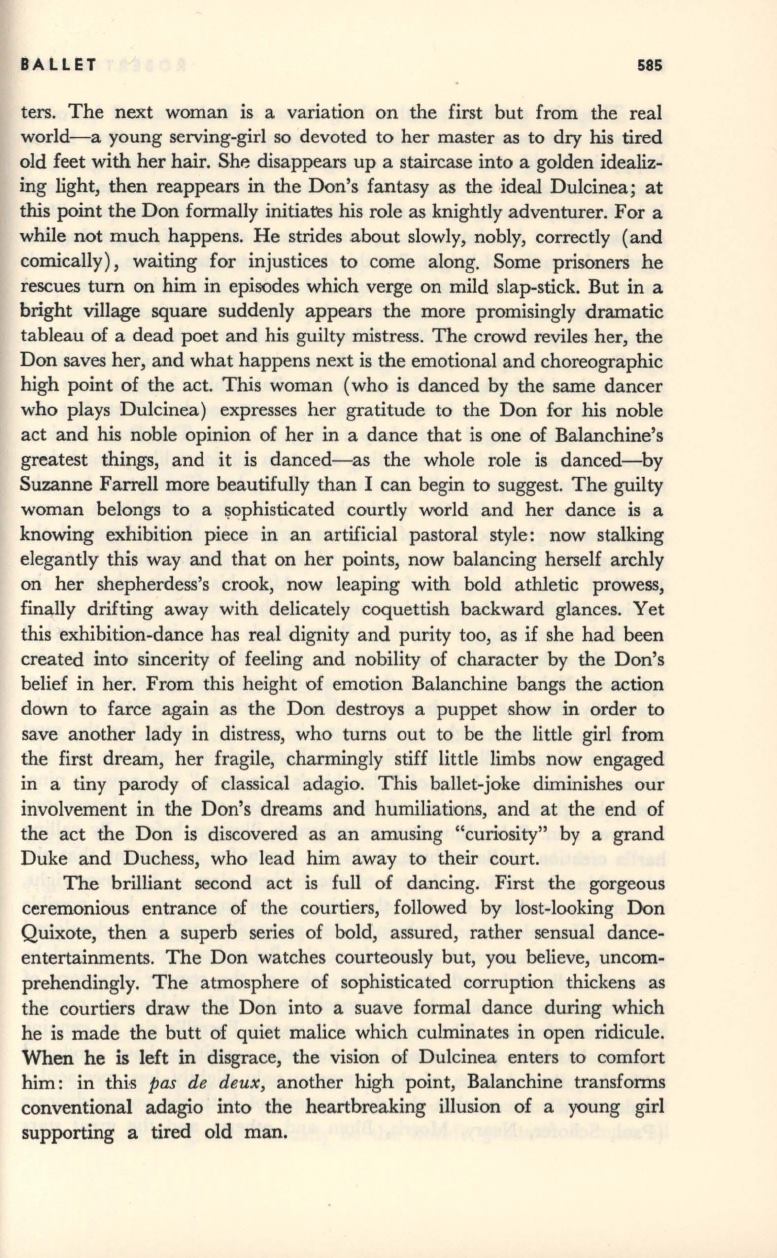
BALLET
585
ters. The next woman is a variation on the first but from the real
world-a young serving-girl so devoted to her master as to dry his tired
old feet with her hair.
Sh~
disappears up a staircase into a golden idealiz–
ing light, then reappears in the Don's fantasy as the ideal Dulcinea; at
this point the Don formally initiates his role as knightly adventurer. For a
while not much happens. He strides about slowly, nobly, correctly (and
comically), waiting for injustices to come along. Some prisoners he
rescues turn on
him
in episodes which verge on mild slap-stick. But in a
bright village square suddenly appears the more promisingly dramatic
tableau of a dead poet and his guilty mistress. The crowd reviles her, the
Don saves her, and what happens next is the emotional and choreographic
high point of the act. This woman (who is danced by the same dancer
who plays Dulcinea) expresses her gratitude to the Don for his noble
act and his noble opinion of her in a dance that is one of Balanchine's
greatest things, and it is danced-as the whole role is danced-by
Suzanne Farrell more beautifully than I can begin to suggest. The guilty
woman belongs to a $ophisticated courtly world and her dance is a
knowing exhibition piece in an artificial pastoral style: now stalking
elegantly this way and that on her points, now balancing herself archly
on her shepherdess's crook, now leaping with bold athletic prowess,
finally drifting away with delicately coquettish backward glances. Yet
this exhibition-dance has real dignity and purity too, as if she had been
created into sincerity of feeling and nobility of character by the Don's
belief in her. From this height of emotion Balanchine bangs the action
down to farce again as the Don destroys a puppet show in order to
save another lady in distress, who turns out to be the little girl from
the first dream, her fragile, charmingly stiff little limbs now engaged
in a tiny parody of classical adagio. This ballet-joke diminishes our
involvement in the Don's dreams and humiliations, and at the end of
the act the Don is discovered as an amusing "curiosity" by a grand
Duke and Duchess, who lead him away to their court.
The brilliant second act is full of dancing. First the gorgeous
ceremonious entrance of the courtiers, followed by lost-looking Don
Quixote, then a superb series of bold', assured, rather sensual dance–
entertainments. The Don watches courteously but, you believe, uncom–
prehendingly. The atmosphere of sophisticated corruption thickens as
the courtiers draw the Don into a suave formal dance during which
he is made the butt of quiet malice which culminates in open ridicule.
When he is left in disgrace, the vision of Dulcinea enters to comfort
him: in this
pas de deux,
another high point, Balanchine transforms
conventional adagio into the heartbreaking illusion of a young girl
supporting a tired old man.


